
The Rise of AI in Content Marketing: What Small Businesses Need to Know
As we approach 2025, the landscape of content marketing is undergoing a radical transformation, largely driven by the rapid advancements in artificial intelligence (AI). For small businesses, this shift presents both exciting opportunities and potential challenges. Understanding the rise of AI in content marketing is crucial for staying competitive and maximizing engagement in an increasingly digital marketplace.
AI is no longer a futuristic concept reserved for tech giants and multinational corporations. It has become an accessible and powerful tool that small businesses can leverage to enhance their content marketing strategies. From content creation to distribution and analysis, AI is revolutionizing every aspect of the content marketing lifecycle.
The Evolution of AI in Content Marketing
To fully grasp the impact of AI on content marketing, it’s essential to understand its evolution. In the early 2010s, AI in marketing was primarily limited to basic automation tools and rudimentary chatbots. Fast forward to 2025, and we’re witnessing sophisticated AI systems capable of generating human-like text, predicting consumer behavior, and personalizing content at scale.
This rapid progression is due to advancements in machine learning algorithms, natural language processing (NLP), and big data analytics. These technologies have coalesced to create AI systems that can understand context, sentiment, and user intent with remarkable accuracy.
Key AI Applications in Content Marketing
- Content Creation and Curation: AI-powered tools can now generate blog posts, social media content, and even video scripts. While they don’t replace human creativity, they significantly speed up the content creation process and help overcome writer’s block.
- Personalization: AI algorithms analyze user data to deliver hyper-personalized content experiences, increasing engagement and conversion rates.
- SEO Optimization: AI tools can analyze search patterns, predict keyword trends, and optimize content for better search engine rankings.
- Content Distribution: AI helps identify the best channels, times, and formats for content distribution, maximizing reach and engagement.
- Performance Analysis: Advanced AI analytics tools provide deep insights into content performance, helping businesses refine their strategies in real-time.
Why Small Businesses Should Care
The democratization of AI technology means that small businesses now have access to tools and capabilities once reserved for larger enterprises. This levels the playing field and opens up new possibilities for growth and engagement. Here’s why small businesses should pay attention to AI in content marketing:
- Cost-Effectiveness: AI can automate many time-consuming tasks, reducing labor costs and allowing small teams to achieve more with limited resources.
- Improved ROI: By optimizing content creation, distribution, and analysis, AI helps ensure that every piece of content delivers maximum value.
- Enhanced Customer Understanding: AI-driven analytics provide deeper insights into customer behavior and preferences, enabling more targeted and effective marketing strategies.
- Competitive Edge: Early adoption of AI technologies can give small businesses a significant advantage over competitors who are slower to adapt.
- Scalability: AI tools can help small businesses manage and personalize content for a growing audience without a proportional increase in manpower.
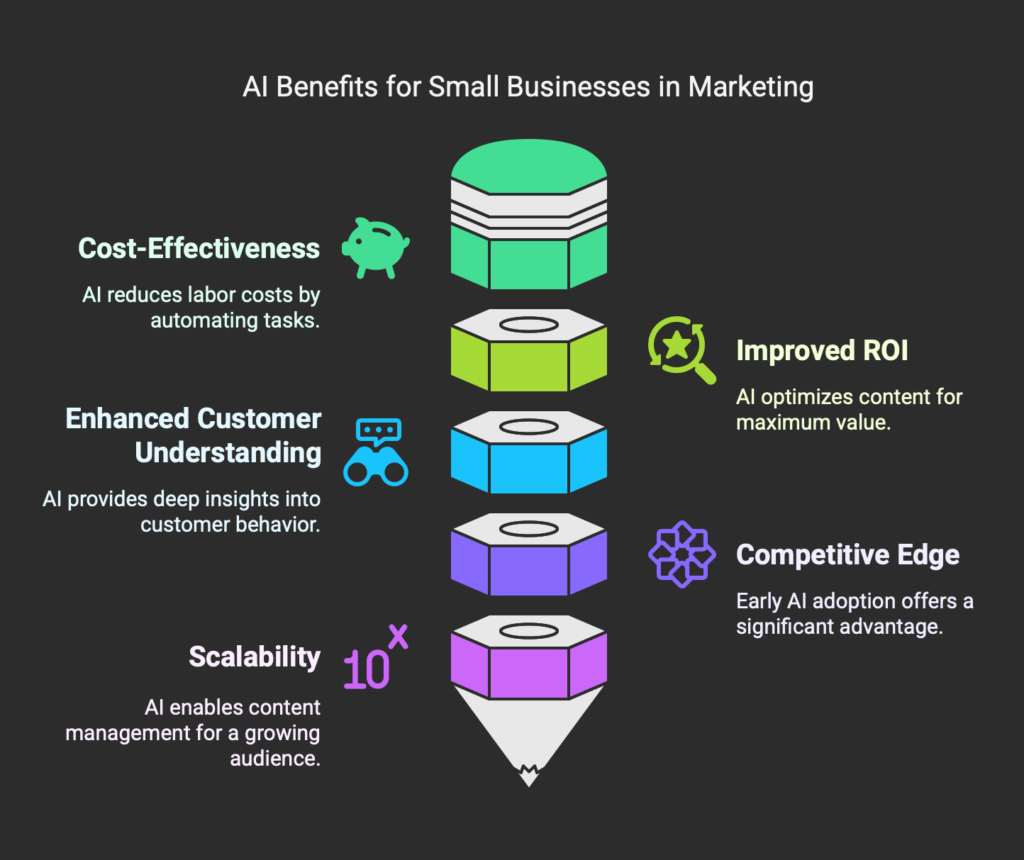
Challenges and Considerations
While the benefits of AI in content marketing are substantial, small businesses should also be aware of potential challenges:
- Learning Curve: Implementing AI tools may require new skills and training for your team.
- Data Privacy: With increased data collection and analysis comes the responsibility of ensuring customer data privacy and compliance with regulations like GDPR.
- Maintaining Authenticity: Over-reliance on AI-generated content can lead to a loss of brand voice and authenticity. It’s crucial to strike a balance between AI assistance and human creativity.
- Cost of Advanced Tools: While many AI tools are becoming more affordable, some advanced solutions may still be costly for small businesses.
- Keeping Up with Rapid Changes: The field of AI is evolving quickly, requiring businesses to stay informed and adapt their strategies continuously.
Leveraging AI-Powered Content Generation Tools for Efficiency
As we look ahead to 2025, small businesses are increasingly turning to artificial intelligence to streamline their content marketing efforts. One of the most promising applications of AI in this field is content generation. By leveraging AI-powered tools, small businesses can create high-quality content more efficiently, allowing them to compete with larger companies and maintain a consistent online presence.
The Power of AI in Content Creation
AI-powered content generation tools use natural language processing (NLP) and machine learning algorithms to analyze vast amounts of data and produce human-like text. These tools can generate various types of content, including blog posts, social media updates, product descriptions, and even video scripts. While AI-generated content may not entirely replace human writers, it can significantly augment their efforts and boost productivity.
Key Benefits for Small Businesses
- Time and Cost Savings: AI can produce content much faster than human writers, allowing small businesses to create more content in less time. This efficiency translates to cost savings, as businesses can reduce their reliance on freelance writers or in-house content teams.
- Consistency: AI-generated content maintains a consistent tone and style across all pieces, ensuring brand coherence even when multiple team members are involved in content creation.
- Scalability: As your business grows, AI tools can easily scale to meet increased content demands without the need for additional human resources.
- 24/7 Content Production: Unlike human writers, AI tools can work around the clock, allowing businesses to maintain a steady stream of content even during off-hours.
- Multilingual Capabilities: Many AI content generation tools can produce content in multiple languages, helping small businesses expand their reach to international audiences.
Best Practices for Leveraging AI Content Generation Tools
While AI-powered content generation tools offer numerous benefits, it’s crucial to use them effectively to maximize their potential. Here are some best practices for small businesses:
- Use AI as a Starting Point: While AI-generated content can be impressive, it’s best to use it as a foundation rather than a final product. Human editors should review and refine the content to ensure it aligns with your brand voice and meets your quality standards.
- Provide Clear Instructions: The quality of AI-generated content often depends on the quality of the input. Provide clear, detailed instructions and keywords to guide the AI in producing relevant and targeted content.
- Combine AI with Human Creativity: Use AI to handle routine content tasks, freeing up your human writers to focus on more creative, strategic, and high-value content projects.
- Maintain a Human Touch: While AI can generate content efficiently, it’s essential to maintain a human element in your content strategy. Personal anecdotes, expert opinions, and unique insights are still best provided by human writers.
- Stay Updated on AI Advancements: The field of AI is rapidly evolving. Stay informed about new tools and features to ensure you’re making the most of available technologies.
- Prioritize SEO: While many AI tools can optimize content for search engines, it’s crucial to review and adjust SEO elements manually to ensure they align with your overall SEO strategy.
- Ensure Ethical Use: Be transparent about your use of AI in content creation and ensure that all generated content complies with copyright laws and ethical guidelines.
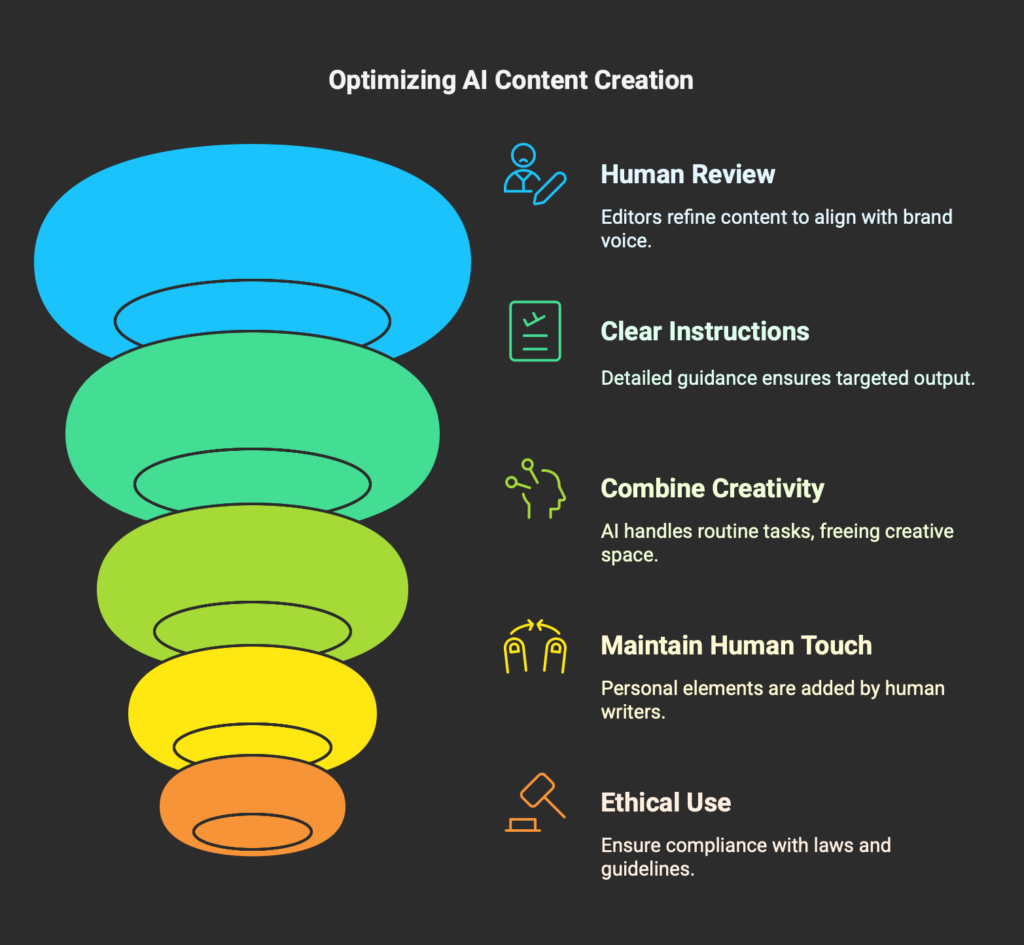
Personalization at Scale: Using AI to Tailor Content to Your Audience
In the rapidly evolving landscape of content marketing, personalization has emerged as a key differentiator for small businesses looking to stand out in a crowded digital space. As we approach 2025, the ability to deliver tailored content experiences to individual users is no longer a luxury—it’s a necessity. This is where artificial intelligence comes into play, offering small businesses the power to personalize content at scale, creating more engaging and relevant experiences for their audience.
The Power of Personalized Content
Before diving into how AI enables personalization at scale, it’s crucial to understand why personalized content is so impactful. Personalized content:
- Increases engagement: When users receive content that speaks directly to their interests and needs, they’re more likely to engage with it.
- Boosts conversion rates: Relevant content can guide users more effectively through the sales funnel.
- Enhances customer loyalty: Consistently delivering valuable, personalized content builds stronger relationships with your audience.
- Improves user experience: Tailored content makes navigation and information discovery more intuitive and satisfying for users.
How AI Enables Personalization at Scale
Traditionally, personalization was a time-consuming and resource-intensive process, often beyond the reach of small businesses. AI has changed this paradigm, making it possible to personalize content for thousands or even millions of users simultaneously. Here’s how:
1. Data Collection and Analysis
AI systems can collect and analyze vast amounts of user data from various sources, including:
- Website behavior (pages visited, time spent, click patterns)
- Social media interactions
- Email engagement
- Purchase history
- Demographic information
This data forms the foundation for creating detailed user profiles and segments, which are essential for effective personalization.
2. Real-Time Content Recommendations
Using machine learning algorithms, AI can analyze user behavior in real-time and make instant content recommendations. This could mean:
- Suggesting relevant blog posts based on the current article a user is reading
- Recommending products that complement items in a user’s shopping cart
- Adjusting homepage content to reflect a user’s interests
3. Dynamic Content Generation
Some AI systems can go beyond recommendations and actually generate personalized content on the fly. This might include:
- Customized email subject lines and body content
- Personalized product descriptions
- Tailored landing pages that adapt to individual user preferences
4. Predictive Personalization
AI doesn’t just react to past behavior—it can predict future interests and needs. By analyzing patterns across large user groups, AI can anticipate what content a user might find valuable next, even if they haven’t explicitly shown interest in that topic before.
Implementing AI-Driven Personalization: Strategies for Small Businesses
While the technology behind AI personalization can be complex, small businesses can still leverage these tools effectively. Here are some strategies to consider:
1. Start with a Solid Data Foundation
Before implementing AI personalization tools, ensure you have a robust system for collecting and organizing user data. This might include:
- Implementing tracking pixels on your website
- Integrating your CRM with your marketing platforms
- Using email marketing tools that track engagement metrics
2. Leverage AI-Powered Marketing Platforms
Many marketing platforms now offer AI-driven personalization features. Look for tools that provide:
- Automated email personalization
- Dynamic website content
- Personalized product recommendations
These platforms often require minimal technical expertise, making them accessible to small businesses.
Overcoming Challenges and Ethical Considerations
While AI-driven personalization offers immense potential, it’s important to be aware of potential challenges and ethical considerations:
- Data Privacy: Ensure that your personalization efforts comply with data protection regulations like GDPR and CCPA.
- Transparency: Be clear with your users about how their data is being used to personalize their experience.
- Avoiding Over-Personalization: Strike a balance between personalization and maintaining a diverse content experience to avoid creating “filter bubbles.”
- Maintaining Brand Consistency: Ensure that personalized content still aligns with your overall brand voice and messaging.
Predictive Analytics: Forecasting Content Trends with AI
As we look ahead to 2025, one of the most powerful applications of AI in content marketing for small businesses will be predictive analytics. This game-changing technology allows marketers to forecast future content trends, audience behaviors, and engagement patterns with unprecedented accuracy. By leveraging AI-powered predictive analytics, small businesses can stay ahead of the curve, create more relevant content, and significantly boost engagement.
Understanding Predictive Analytics in Content Marketing
Predictive analytics uses historical data, machine learning algorithms, and statistical modeling to identify patterns and predict future outcomes. In content marketing, this translates to analyzing past content performance, audience interactions, and market trends to forecast what types of content will resonate most with your target audience in the future.
For small businesses, predictive analytics can be a powerful tool to:
- Identify emerging topics and trends before they become mainstream
- Optimize content creation and distribution strategies
- Predict which content formats will perform best
- Forecast audience engagement levels for different content types
- Anticipate shifts in audience preferences and behaviors
Key Benefits of AI-Powered Predictive Analytics for Small Businesses
- More Efficient Resource Allocation: By accurately predicting which content types and topics will perform best, small businesses can focus their limited resources on creating high-impact content that’s more likely to engage their audience.
- Improved Content Relevance: Predictive analytics helps businesses stay ahead of trends, ensuring their content remains fresh, timely, and highly relevant to their target audience.
- Enhanced Personalization: AI can predict individual user preferences and behaviors, allowing for hyper-personalized content recommendations and experiences.
- Better Timing: Predictive models can determine the optimal times to publish and promote content for maximum engagement.
- Increased ROI: By focusing on content that’s predicted to perform well, businesses can achieve higher engagement rates and a better return on their content marketing investments.
Implementing Predictive Analytics in Your Content Strategy
1. Collect and Analyze Historical Data
The foundation of effective predictive analytics is high-quality, comprehensive data. Start by gathering historical data on your content performance, including metrics like:
- Page views
- Time on page
- Social shares
- Conversion rates
- Engagement rates (comments, likes, etc.)
- Click-through rates
Also, collect data on external factors that may influence content performance, such as seasonal trends, industry events, economic indicators, and competitor activities.
2. Leverage AI-Powered Tools
Several AI-powered tools are available to help small businesses implement predictive analytics in their content marketing strategies. These tools use machine learning algorithms to analyze your historical data and provide actionable insights and predictions.
3. Identify Key Predictive Metrics
Work with your AI tools to identify the most relevant predictive metrics for your business. These might include content topic performance, keyword trends, audience segment engagement, content format preferences, and optimal publishing times.
4. Develop Predictive Models
Use your chosen AI tools to develop predictive models based on your historical data and key metrics. These models will help you forecast future content performance and audience behaviors.
5. Test and Refine Your Models
Regularly test your predictive models against actual results and refine them as needed. AI algorithms improve over time with more data, so continuous testing and optimization are crucial.
6. Integrate Predictions into Your Content Strategy
Use the insights gained from your predictive analytics to inform your content creation and distribution strategies. This might involve prioritizing content topics predicted to perform well, adjusting your content mix based on predicted format preferences, optimizing your content calendar based on predicted engagement times, and tailoring content to specific audience segments based on predicted behaviors.
Challenges and Considerations
While predictive analytics offers tremendous potential for small businesses, there are some challenges to consider:
- Data Quality: Predictive models are only as good as the data they’re based on. Ensure you have clean, comprehensive data for accurate predictions.
- Overreliance on Predictions: While predictive analytics can provide valuable insights, it’s important to balance these predictions with human intuition and creativity.
- Privacy Concerns: As you collect and analyze user data, be mindful of privacy regulations and ethical considerations.
- Resource Investment: Implementing AI-powered predictive analytics may require an initial investment in tools and expertise.
AI-Driven SEO Optimization: Boosting Your Content’s Visibility
In the ever-evolving landscape of digital marketing, search engine optimization (SEO) remains a critical component for small businesses aiming to increase their online visibility. As we look ahead to 2025, the integration of artificial intelligence in SEO practices is set to revolutionize how businesses approach content optimization. AI-driven SEO tools are becoming increasingly sophisticated, offering small businesses powerful capabilities to compete with larger corporations in the digital space.
Understanding AI-Driven SEO
AI-driven SEO refers to the use of machine learning algorithms and natural language processing to analyze, predict, and optimize content for better search engine rankings. Unlike traditional SEO methods that rely heavily on manual keyword research and optimization, AI-powered tools can process vast amounts of data to identify patterns and insights that humans might miss. This technology enables small businesses to make data-driven decisions and implement SEO strategies with greater precision and efficiency.
Key Benefits of AI-Driven SEO for Small Businesses
1. Enhanced Keyword Research and Analysis
AI algorithms can analyze search trends, user intent, and competitor strategies to identify the most valuable keywords for your business. These tools can uncover long-tail keywords and semantic variations that may have been overlooked in manual research. By leveraging AI for keyword discovery, small businesses can target more specific, less competitive niches and improve their chances of ranking higher in search results.
2. Content Optimization in Real-Time
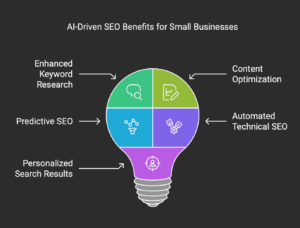 AI-powered SEO tools can analyze your content in real-time and provide suggestions for optimization. This includes recommendations for improving readability, adjusting keyword density, and enhancing overall content structure. Some advanced tools can even suggest additional topics or subtopics to cover, ensuring your content is comprehensive and aligns with user intent.
AI-powered SEO tools can analyze your content in real-time and provide suggestions for optimization. This includes recommendations for improving readability, adjusting keyword density, and enhancing overall content structure. Some advanced tools can even suggest additional topics or subtopics to cover, ensuring your content is comprehensive and aligns with user intent.
3. Predictive SEO
By analyzing historical data and current trends, AI can predict future SEO opportunities and challenges. This foresight allows small businesses to stay ahead of the curve, adjusting their content strategy proactively rather than reactively. Predictive SEO can help identify emerging topics, seasonal trends, and potential algorithm changes that may impact your visibility.
4. Automated Technical SEO
AI can streamline technical SEO tasks such as site crawling, identifying broken links, and optimizing page load speeds. These tools can quickly scan your entire website, flagging issues that could negatively impact your search rankings. By automating these processes, small businesses can maintain a technically sound website without dedicating extensive resources to manual audits.
5. Personalized Search Results
As search engines become more sophisticated in delivering personalized results, AI-driven SEO tools can help small businesses optimize for different user segments. By analyzing user behavior and preferences, these tools can suggest content variations that cater to specific audience demographics, locations, or search histories.
Implementing AI-Driven SEO Strategies
To effectively leverage AI for SEO optimization, small businesses should consider the following strategies:
1. Invest in AI-Powered SEO Tools
While there are many SEO tools available, look for those that specifically incorporate AI and machine learning capabilities. Popular options include SEMrush, Ahrefs, and Moz, which offer AI-driven features for keyword research, content optimization, and competitor analysis. As AI technology advances, we can expect even more specialized tools to emerge by 2025.
2. Focus on Natural Language Processing (NLP)
With the rise of voice search and conversational AI, optimizing content for natural language queries is becoming increasingly important. AI-driven SEO tools that utilize NLP can help you create content that aligns with how people naturally speak and ask questions. This approach can improve your visibility in voice search results and featured snippets.
3. Utilize AI for Content Creation and Optimization
AI-powered content creation tools can help generate SEO-friendly content ideas, outlines, and even draft articles. While human oversight is still crucial for quality and brand voice consistency, these tools can significantly speed up the content creation process. Additionally, AI can analyze existing content and suggest improvements to make it more SEO-friendly.
4. Implement Dynamic Content Optimization
AI can help create dynamically optimized content that adjusts based on user behavior and search trends. This could involve automatically updating meta tags, headings, or content sections to align with current search patterns. By 2025, we may see more websites leveraging AI to create truly adaptive content experiences.
5. Leverage AI for Local SEO
For small businesses with a local presence, AI can be particularly valuable in optimizing for local search. AI-driven tools can analyze local search patterns, competitor strategies, and user behavior to help businesses improve their visibility in local search results and Google My Business listings.
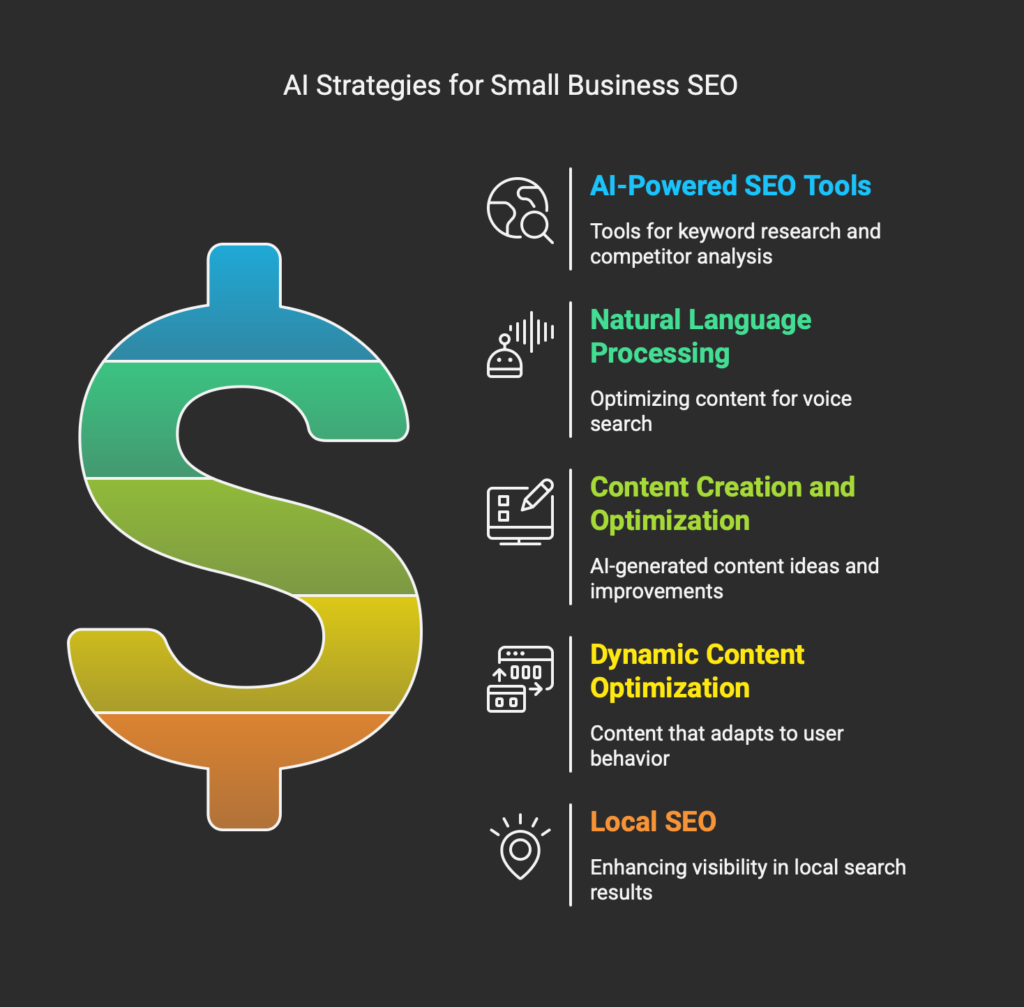
Challenges and Considerations
While AI-driven SEO offers numerous benefits, small businesses should be aware of potential challenges:
- Data Privacy and Security: As AI tools process large amounts of data, ensuring compliance with data protection regulations is crucial.
- Over-Optimization: Relying too heavily on AI recommendations without human oversight could lead to content that feels unnatural or over-optimized.
- Cost: Advanced AI-powered SEO tools may come with a higher price tag, which could be a barrier for some small businesses.
- Keeping Up with AI Advancements: The field of AI is rapidly evolving, requiring ongoing education and adaptation to new tools and techniques.
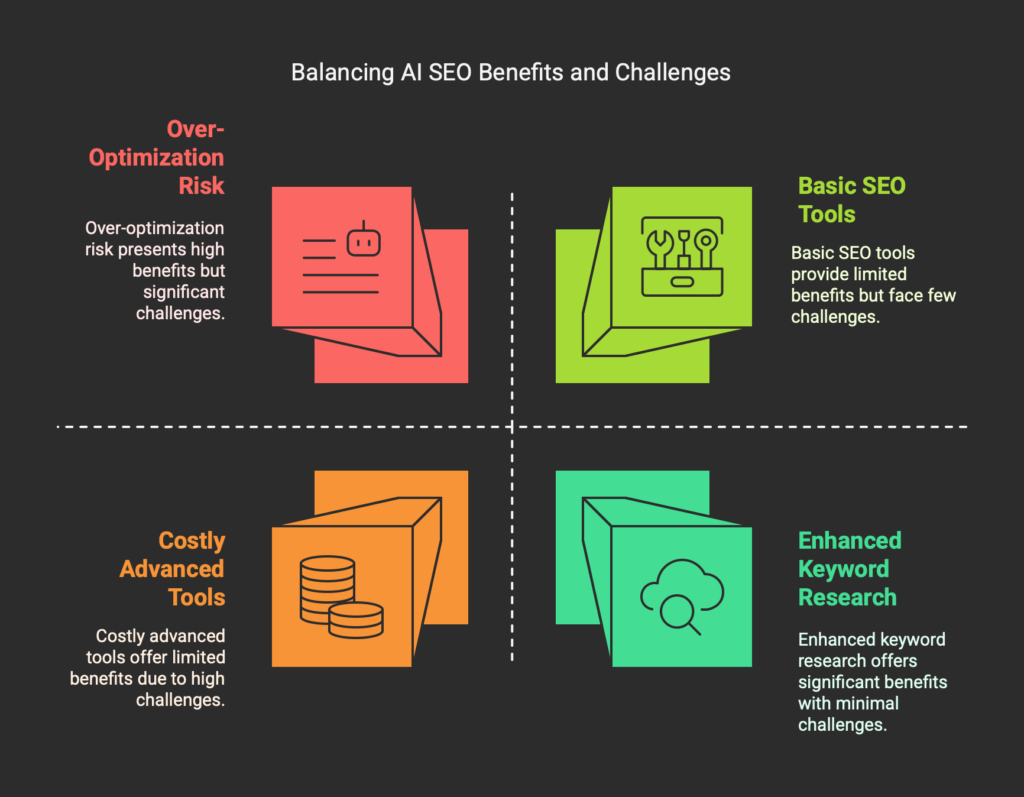
Chatbots and Conversational AI: Enhancing User Engagement
As we look ahead to 2025, chatbots and conversational AI are set to revolutionize how small businesses engage with their audience through content marketing. These AI-powered tools offer a unique opportunity to provide personalized, interactive experiences that can significantly boost user engagement and drive better results from your content efforts.
The Evolution of Chatbots and Conversational AI
Chatbots have come a long way since their inception. Early chatbots were rule-based systems with limited capabilities, often frustrating users with their inability to understand context or handle complex queries. However, the rapid advancements in natural language processing and machine learning have given rise to more sophisticated conversational AI systems that can engage in human-like interactions.
By 2025, we expect to see chatbots and conversational AI that can:
- Understand and respond to complex queries with high accuracy
- Recognize user intent and emotion
- Provide personalized recommendations based on user behavior and preferences
- Seamlessly integrate with other marketing tools and platforms
- Learn and improve from each interaction
Integrating Chatbots into Your Content Strategy
To leverage chatbots and conversational AI effectively in your content marketing efforts, consider the following strategies:
1. Interactive Content Delivery
Use chatbots to deliver your content in an interactive, conversational format. Instead of presenting a static blog post or article, allow users to engage with the content through a chat interface. The chatbot can ask questions, provide summaries, and offer additional information based on the user’s interests.
2. Personalized Content Recommendations
Implement chatbots that can analyze user behavior and preferences to recommend relevant content from your library. This personalized approach can increase content consumption and keep users engaged with your brand for longer periods.
3. Content Discovery Assistance
Create a chatbot that acts as a content concierge, helping users navigate your website and find the most relevant information for their needs. This can be particularly useful for businesses with extensive content libraries or complex product offerings.
4. Lead Generation and Qualification
Use conversational AI to engage potential leads through your content, asking qualifying questions and guiding them towards the most appropriate resources or offers based on their responses.
5. Real-time Content Updates
Leverage chatbots to deliver real-time updates on trending topics or breaking news related to your industry. This can position your brand as a go-to source for timely information.
Best Practices for Implementing Chatbots in Content Marketing
To ensure your chatbot and conversational AI efforts enhance rather than hinder user engagement, keep these best practices in mind:
- Maintain a Human Touch: While AI powers the conversation, it’s crucial to infuse your chatbot with your brand’s personality and tone of voice. This helps create a more authentic and relatable experience for users.
- Be Transparent: Always make it clear to users that they are interacting with an AI system. This builds trust and sets appropriate expectations for the interaction.
- Provide Easy Access to Human Support: Ensure that users can easily escalate to human support when needed. This is especially important for complex queries or sensitive issues that may require a human touch.
- Continuously Train and Improve: Regularly analyze chatbot interactions to identify areas for improvement. Use this data to refine your AI models and enhance the chatbot’s capabilities over time.
- Respect User Privacy: Be transparent about data collection and usage. Implement strong privacy measures to protect user information gathered through chatbot interactions.
Challenges and Considerations
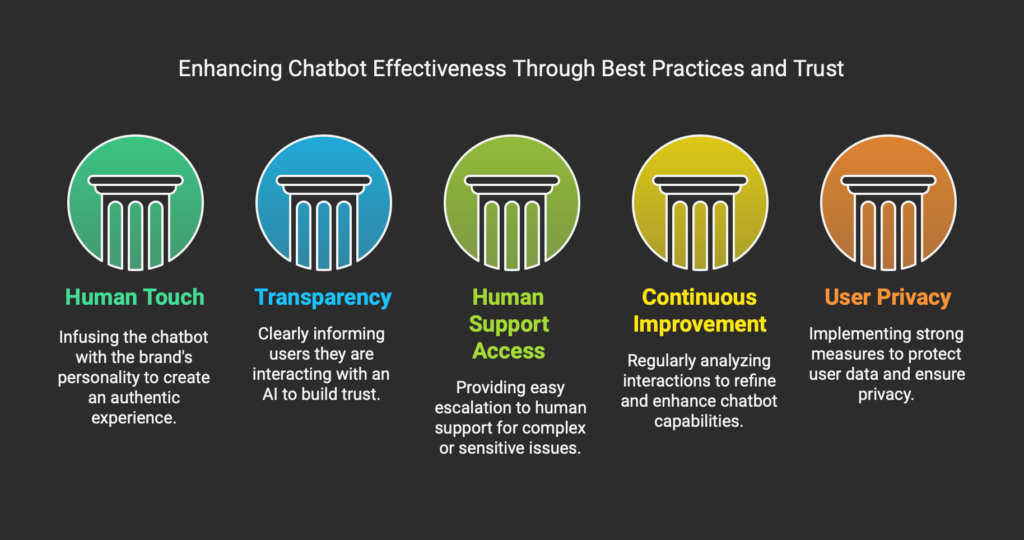 While the benefits of chatbots and conversational AI in content marketing are significant, there are challenges to consider:
While the benefits of chatbots and conversational AI in content marketing are significant, there are challenges to consider:
- Initial Setup and Training: Developing a sophisticated chatbot requires significant upfront investment in terms of time and resources. Small businesses may need to partner with AI specialists or use third-party platforms to implement effective solutions.
- Maintaining Accuracy and Relevance: As your content library grows and market conditions change, ensuring your chatbot remains accurate and up-to-date can be challenging. Regular maintenance and updates are essential.
- Balancing Automation and Human Interaction: Finding the right balance between AI-driven interactions and human touch points is crucial. Over-reliance on chatbots can lead to a loss of personal connection with your audience.
- Data Privacy and Security: As chatbots collect and process user data, ensuring compliance with data protection regulations and maintaining robust security measures becomes increasingly important.
Measuring Success: AI Tools for Content Performance Analysis
In the ever-evolving landscape of content marketing, measuring the success of your efforts is crucial for small businesses looking to maximize their return on investment. As we approach 2025, artificial intelligence is revolutionizing the way we analyze content performance, offering unprecedented insights and actionable data. In this section, we’ll explore how small businesses can leverage AI-powered tools to measure and optimize their content marketing success.
1. Advanced Analytics Platforms
AI-driven analytics platforms are becoming increasingly sophisticated, providing small businesses with enterprise-level insights without the need for a dedicated data science team. These platforms use machine learning algorithms to process vast amounts of data, identifying patterns and trends that human analysts might miss.
Key features to look for in AI-powered analytics platforms include:
- Real-time data processing and visualization
- Predictive analytics for future content performance
- Automated anomaly detection to highlight unusual trends
- Natural language processing for sentiment analysis of user comments and feedback
Popular AI analytics tools like Google Analytics 4 and Adobe Analytics are continually improving their AI capabilities, making them more accessible and valuable for small businesses.
2. Content Attribution Modeling
Understanding which pieces of content contribute most to conversions is essential for optimizing your marketing strategy. AI-powered attribution modeling goes beyond traditional last-click attribution, providing a more nuanced view of the customer journey.
These models use machine learning to analyze touchpoints across various channels, assigning appropriate credit to each piece of content in the conversion path. This allows small businesses to:
- Identify top-performing content at different stages of the funnel
- Understand the synergies between different content types and channels
- Optimize content distribution strategies for maximum impact
3. Automated Content Audits
Regular content audits are essential for maintaining a high-quality, relevant content library. However, manually reviewing large volumes of content can be time-consuming and prone to human error. AI-powered content audit tools can streamline this process, automatically analyzing your content for:
- SEO optimization
- Readability and clarity
- Topical relevance
- Duplicate or thin content
- Outdated information
These tools can provide actionable recommendations for improvement, helping small businesses maintain a competitive edge in their content marketing efforts.
4. AI-Powered A/B Testing
A/B testing is a crucial technique for optimizing content performance, but traditional methods can be time-consuming and limited in scope. AI-powered A/B testing tools use machine learning algorithms to:
- Automatically generate multiple content variations
- Dynamically allocate traffic to top-performing variants
- Analyze results in real-time and make data-driven decisions
This allows small businesses to conduct more comprehensive tests with less manual effort, leading to faster optimization and improved content performance.
5. Predictive Content Performance
AI algorithms can analyze historical data and current trends to predict the potential performance of new content before it’s even published. This capability allows small businesses to:
- Prioritize content creation efforts based on predicted impact
- Optimize content topics, formats, and distribution channels
- Identify potential gaps in the content strategy
6. Automated Competitive Analysis
Staying ahead of the competition is crucial for small businesses in crowded markets. AI-powered competitive analysis tools can automatically monitor competitors’ content strategies, providing valuable insights such as:
- Content topics and themes that are performing well in your industry
- Gaps in competitors’ content that you can exploit
- Benchmarking of your content performance against industry standards
7. Sentiment Analysis and Social Listening
Understanding how your audience perceives your content is crucial for refining your strategy and maintaining a positive brand image. AI-powered sentiment analysis tools can:
- Monitor social media mentions and comments
- Analyze customer feedback across various channels
- Identify emerging trends and topics of interest among your audience
This information can help small businesses tailor their content to better meet audience needs and address potential issues proactively.
8. Content Recommendation Engines
AI-powered recommendation engines can analyze user behavior and preferences to suggest relevant content, improving engagement and reducing bounce rates. These tools can:
- Personalize content recommendations for individual users
- Identify cross-selling and upselling opportunities
- Increase time on site and pages per session
Implementing a content recommendation engine can significantly boost the performance of your existing content library.
Conclusion
As we move towards 2025, AI tools for content performance analysis are becoming increasingly accessible and valuable for small businesses. By leveraging these technologies, you can gain deeper insights into your content’s performance, make data-driven decisions, and continuously optimize your content marketing strategy.
To get started, consider implementing one or two AI-powered tools that align with your most pressing content analysis needs. As you become more comfortable with these technologies, you can gradually expand your AI toolkit to cover more aspects of content performance measurement and optimization.
Remember, while AI can provide powerful insights and automate many aspects of content analysis, human creativity and strategic thinking remain essential. Use AI as a tool to augment your decision-making process and free up time for more high-level strategic planning and creative content development.
By embracing AI-driven content performance analysis, small businesses can level the playing field with larger competitors, making more efficient use of their resources and driving better results from their content marketing efforts.
